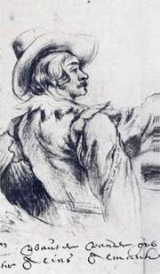
Wouter Crabeth II
Encyclopedia
Biography
Wouter Crabeth was born in GoudaGouda
Gouda is a city and municipality in the western Netherlands, in the province of South Holland. Gouda, which was granted city rights in 1272, is famous for its Gouda cheese, smoking pipes, and 15th-century city hall....
in 1594, the son of the writer and politician Pieter Woutersz. Crabeth. He was named after his grandfather Wouter Crabeth I
Wouter Crabeth I
Wouter Pietersz Crabeth , was a Dutch Renaissance glass painter. He was employed by the Janskerk during the Protestant Reformation, where he created six of the stained glass windows during the years 1555-1571...
, who was a celebrated master glassmaker. Crabeth took an apprenticeship under Cornelis Ketel, uncle of Cornelis Ketel le Jeune
Cornelis Ketel
Cornelis or Cornelius Ketel was a Dutch Mannerist painter, active in Elizabethan London from 1573 to 1581, and in Amsterdam from 1581 to the early 17th century, now known essentially as a portrait-painter, though he was also a poet and orator, and from 1595 began to sculpt as well.According to...
, who was well-known. It is possible that he was also the student of Abraham Bloemaert
Abraham Bloemaert
Abraham Bloemaert was a Dutch painter and printmaker in etching and engraving. He was one of the "Haarlem Mannerists" from about 1585, but in the new century altered his style to fit new Baroque trends...
in Utrecht.
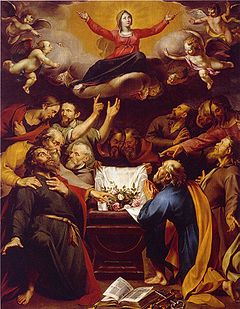
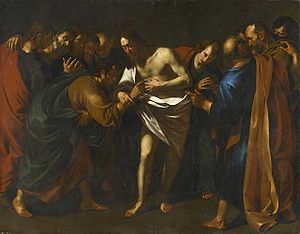
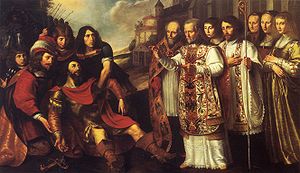
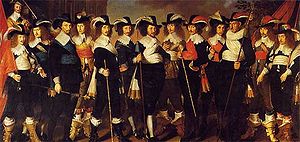
Grand Tour
The Grand Tour was the traditional trip of Europe undertaken by mainly upper-class European young men of means. The custom flourished from about 1660 until the advent of large-scale rail transit in the 1840s, and was associated with a standard itinerary. It served as an educational rite of passage...
. Such a tour, ending in Florence
Florence
Florence is the capital city of the Italian region of Tuscany and of the province of Florence. It is the most populous city in Tuscany, with approximately 370,000 inhabitants, expanding to over 1.5 million in the metropolitan area....
and Rome
Rome
Rome is the capital of Italy and the country's largest and most populated city and comune, with over 2.7 million residents in . The city is located in the central-western portion of the Italian Peninsula, on the Tiber River within the Lazio region of Italy.Rome's history spans two and a half...
, was considered a necessary rite of passage for completing a Flemish artist's classical education, ever since Karel van Mander's Schilderboeck was published in 1604. He was in Paris
Paris
Paris is the capital and largest city in France, situated on the river Seine, in northern France, at the heart of the Île-de-France region...
in 1615 and in Aix-en-Provence
Aix-en-Provence
Aix , or Aix-en-Provence to distinguish it from other cities built over hot springs, is a city-commune in southern France, some north of Marseille. It is in the region of Provence-Alpes-Côte d'Azur, in the département of Bouches-du-Rhône, of which it is a subprefecture. The population of Aix is...
the following year. Then he travelled to Italy, where he studied the local masterpieces and worked at the various painting schools and workshops. In 1619, while in Rome
Rome
Rome is the capital of Italy and the country's largest and most populated city and comune, with over 2.7 million residents in . The city is located in the central-western portion of the Italian Peninsula, on the Tiber River within the Lazio region of Italy.Rome's history spans two and a half...
, he became a member of the Bentvueghels
Bentvueghels
The Bentvueghels were a society of mostly Dutch and Flemish artists active in Rome from about 1620 to 1720. They are also known as the Schildersbent .-Activities:...
, with other painters such as Cornelius van Poelenburgh
Cornelius van Poelenburgh
Cornelis van Poelenburgh, was a Dutch Golden Age landscape painter.-Biography:Though his birthplace is unknown, a signed document survives in Utrecht where he is listed as six years old and the son of Simon van Poelenburch, a Catholic canon in Utrecht. He initially trained with Abraham Bloemaert,...
, Bartholomeus Breenbergh
Bartholomeus Breenbergh
Bartholomeus Breenbergh was a Dutch Golden Age painter of Italianate landscapes.-Biography:Little is known of his early life. In his famous three volume Schouburg, Arnold Houbraken mentioned him in his first volume with an entreaty to readers to write him with more news of Breenberg's biography...
, Wybrand de Geest
Wybrand de Geest
Wybrand Simonsz. de Geest was a Dutch Golden Age portrait painter from Friesland.-Biography:...
and Leonard Bramer. They gave him the nickname "De Almanack" (The Almanac). Crabeth is represented in an anonymous drawing (see sidebar in top-right) drawn in 1620 and saved in the Museum Boijmans Van Beuningen
Museum Boijmans Van Beuningen
The Museum Boijmans Van Beuningen is the main art museum in Rotterdam, the Netherlands. The museum began in 1847 with the collection of Frans Jacob Otto Boijmans . Much of the museum's original collection was destroyed in a disastrous 1864 fire...
in Rotterdam. Crabeth was then known as Wouter van der Gou (i.e. Wouter of Gouda); he was often seen together with other members of the Bentvueghels.
In 1626, he returned to Gouda, as a schutter, (soldier). In 1628, he married the mayor's daughter, Adriana Gerritsdr Vroesen. The same year, at the time that his own father became mayor, he was named captain of the Schutterij
Schutterij
Schutterij refers to a voluntary city guard or citizen militia in the medieval and early modern Netherlands, intended to protect the town or city from attack and act in case of revolt or fire. Their training grounds were often on open spaces within the city, near the city walls, but, when the...
, a function which he continued until his death in 1644. In this role, in 1629, he took part in the Siege of 's-Hertogenbosch
Siege of 's-Hertogenbosch
The Siege of 's-Hertogenbosch was in 1629 an action of the Eighty Years' War in which a Dutch Republican army captured the city of 's-Hertogenbosch which had been loyal to the King of Spain since 1579 and thus part of the Spanish Netherlands.-Background:...
.
Before that, he received an order from curate Petrus Purmerent for two altars for the Catholic Church of Saint-Jean-Baptiste (later the Old Catholic Church
Old Catholic Church
The term Old Catholic Church is commonly used to describe a number of Ultrajectine Christian churches that originated with groups that split from the Roman Catholic Church over certain doctrines, most importantly that of Papal Infallibility...
) and Catharinagasthuis, a religious community. These two paintings are currently held in the Museum Het Catharina Gasthuis in Gouda and the Rijksmuseum
Rijksmuseum
The Rijksmuseum Amsterdam or simply Rijksmuseum is a Dutch national museum in Amsterdam, located on the Museumplein. The museum is dedicated to arts, crafts, and history. It has a large collection of paintings from the Dutch Golden Age and a substantial collection of Asian art...
of Amsterdam. The two works – The Assumption of the Virgin Mary (Ten-Hemelopneming van Maria) and Doubting Thomas (Ongelovige Thomas) – show a strong Italian influence, and are stylistically close to Caravaggio
Caravaggio
Michelangelo Merisi da Caravaggio was an Italian artist active in Rome, Naples, Malta, and Sicily between 1593 and 1610. His paintings, which combine a realistic observation of the human state, both physical and emotional, with a dramatic use of lighting, had a formative influence on the Baroque...
. In 1631 and 1641, Crabeth painted another two altars for the Church of Saint-Jean-Baptiste, which are also at the Museum Het Catharina Gasthuis.
As well as altars, Crabeth often painted card players and shepherds, which are very close in spirit to the works of Caravaggio. These tableaux were mostly painted after his return to Gouda. Only a small number of these works remain.
Wouter Crabeth was succeeded by his students Jan Ariens Duif
Jan Ariens Duif
Jan Ariens Duif was a Dutch Golden Age painter.-Biography:He was taken to the Gouda orphanage at age nine, where his drawing talent was discovered and ten years later he painted the regents with himself next to the resident father. He was a student of his uncle, Wouter Crabeth II. He married in...
, Dirk de Vrije, Jan Govertsz Verbijl, Jan Verzijl and Aert Van Waes
Aert van Waes
Aert van Waes, or Aert de Waes , was a Dutch Golden Age painter of the Baroque period.-Biography:He was a student of Wouter Crabeth II, Reinier van Persijn and David Teniers the Younger, and though he lived and worked in Gouda, he travelled in France and Italy to finish his training., According to...
. Crabeth was the most important Dutch Golden Age
Dutch Golden Age
The Golden Age was a period in Dutch history, roughly spanning the 17th century, in which Dutch trade, science, military and art were among the most acclaimed in the world. The first half is characterised by the Eighty Years' War till 1648...
artist in the town of Gouda.
Description by Ignatius Walvis
The historian Walvis, of Gouda, wrote in 1713:One of the main disciples of Ketel, Wouter Crabeth, grandson of the illustrator and glass painter Wouter Pietersz Crabet. This Wouter visited France, Italy, and all the painting schools of Rome, after which, a voyage of 13 years, he returned to Gouda where, in 1628, he married Adriana Vroesen. His most important works are the Assumption of the Virgin Mary, on the altar of the priory of I.W. [= Ignatius Walvis]. His last great work of portraiture, the Council of War of Gouda which was then in office, represented by its large size, is hung in the hall of Saint Joris Doelen.--Ignatius Walvis
Works of Wouter Crabeth II
- The Adoration of the Magi (Aanbidding der Koningen), 1631 (Museum het Catharina Gasthuis Gouda).
- Amusement of the shepherds (Herdersvermaak) (Koninklijk Museum voor Schone KunstenKoninklijk Museum voor Schone KunstenThe Royal Museum of Fine Arts is a museum in Antwerp, Belgium, founded in 1810, houses a collection of paintings, sculptures and drawings from the fourteenth to the twentieth centuries...
, Anvers). - The Assumption of the Virgin Mary (Ten-Hemelopneming van Maria), 1628 (Museum het Catharina Gasthuis, Gouda).
- The Assumption of the Virgin Mary was conceived in 1628 by Crabeth as an altar, which was commissioned by the priest Petrus Purmerent for schuilkerkSchuilkerkA clandestine church , defined by historian Benjamin J. Kaplan as a "semi-clandestine church", is a house of worship used by religious minorities whose communal worship is tolerated by those of the majority faith on condition that it is discreet and not conducted in public spaces...
. Forgotten for more than three centuries, it was rediscovered in 1970 – in the attic of the rectory – by the then director of the Catharina Gasthuis in Gouda, Dr. Jan Schouten. The work is now exhibited in the new museum.
- The Assumption of the Virgin Mary was conceived in 1628 by Crabeth as an altar, which was commissioned by the priest Petrus Purmerent for schuilkerk
- The Drinkers (attributed; place of conservation unknown, sold on 11 March 1999 by Marc-Arthur Kohn of Paris).
- Company of musicians. (Szépmüvézeti Muzeum, Budapest).
- The Conversion of Guillaume d’Aquitaine by Bernard de Clairvaux (Bernardus van Clairvaux bekeert Willem van Aquitanië, 1641 (Museum het Catharina Gasthuis Gouda).
- Couple playing the flute (Koninklijk Museum voor Schone KunstenKoninklijk Museum voor Schone KunstenThe Royal Museum of Fine Arts is a museum in Antwerp, Belgium, founded in 1810, houses a collection of paintings, sculptures and drawings from the fourteenth to the twentieth centuries...
, Anvers). - The dying warrior (Stervende krijgsman) (private collection).
- The card players (Muzeum Narodowe, Warsaw).
- The card players (place of conservation unknown, sold at auction 17 January 1992 by Sotheby's in New York).
- Harmanus Herberts and his officials, 1642 (Museum het Catharina Gasthuis Gouda).
- La Mise au tombeau, probably destroyed in 1945 (last seen in the Kaiser-Friedrich-Museum, in Berlin).
- Les Noces de Cana (De Bruiloft te Kana), painted 1640 (Museum het Catharina Gasthuis Gouda).
- Doubting Thomas (Ongelovige Thomas), around 1628 (RijksmuseumRijksmuseumThe Rijksmuseum Amsterdam or simply Rijksmuseum is a Dutch national museum in Amsterdam, located on the Museumplein. The museum is dedicated to arts, crafts, and history. It has a large collection of paintings from the Dutch Golden Age and a substantial collection of Asian art...
, Amsterdam – loaned to the Catharina Gasthuis (MuseumgoudA), Gouda). - Les Tricheurs (Gemäldegalerie, Berlin).
Sources
J. Schouten, Wie waren zij ? Een reeks van Goudse mannen en vrouwen die men niet mag vergeten, Repro-Holland, Alphen aan den Rijn, 1980. Xander Van Eck, Kunst, twist en devotie, Eburon, Delft, 1994 ISBN 90-5166-408-7 De Gilden in Gouda, Museum Het Catharina Gasthuis Gouda - Waanders Zwolle, Gouda, 1996,ISBN 90 400 9924 3 I. Walvis, Beschrijving der stad Gouda door I.W., 2 dln., Gouda, 1713, éd. fac-similée 1972 Rudie Van Leeuwen, « Portretten op een contrareformatorisch altaarstuk : Wouter Pietersz. Crabeths Ten Hemelopneming van Maria uit 1628 », in Desipientia : Zin & Waan, année 14, nr. 2 (nov. 2007), p. 44-45. Benedict NicolsonBenedict Nicolson
Benedict Nicolson, MVO was a British art historian and author.Nicolson was the elder son of authors Harold Nicolson and Vita Sackville-West and the brother of writer and politician Nigel...
, Burlington Magazine, Caravaggism in Europe, 1989.

